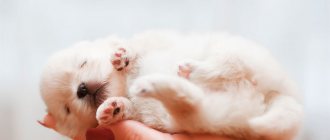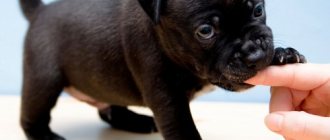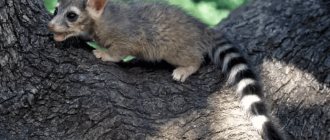14375Pavel
In order to determine how healthy a kitten is, it is very important for future owners and breeders to study the development of kittens week by week. How strong a kitten is, whether it needs additional stimulation of the immune system or care can be determined by recording changes in the development of kittens by day after birth. The correct growth of a small pet depends not only on a properly structured diet, upbringing and training, but also on compliance with the rules that are established for caring for kittens.
Features of development in the first week
Kittens develop especially rapidly in the days after birth. After birth, he weighs no more than 100 grams and gains about the same amount in the first week. Underweight or excess weight directly affects development, so you need to monitor it and regularly weigh your pet.
During the first 3 days of life, as a rule, the umbilical cord falls off, which the cat can care for independently. But in order to prevent the occurrence of inflammation, kittens are recommended to treat the umbilical cord in the first days of life with a weak solution of potassium permanganate.
A newborn kitten is always blind and begins to see only after three weeks from birth. Few people know such a feature as congenital deafness, which disappears only by 5 days after birth. A deaf baby does not even respond to his mother's voice.
It is especially important to arrange a place for the cat in advance so that small kittens during the period of deafness can easily find their mother . The development of kittens from birth occurs very rapidly; it is during this period that he receives his first food in the form of mother's milk, which ensures that all necessary microelements and nutrients enter the body. Natural nutrition is very important for the development of a kitten, since it also includes antibodies that the baby needs to form immunity.
© shutterstock
Although the baby does not see or hear in the first days of his life, he perfectly uses his sense of smell, with the help of which he identifies his mother. Kittens are born with a sense of smell that allows them to find a cat, even if it is within a radius of 60 centimeters from the kitten. In order to ensure the proper development of the kitten, it is necessary to prepare a place for the cat in which drafts and sudden changes in temperature will be completely excluded. This will not only protect the baby from colds, but also provide comfortable conditions for growth.
The second stage is independence and growing up
| Age | Image | Peculiarities | Recommendations |
| Sixth week | The final transition from mother's milk to foreign food | Feed the kitten 6 times a day, 40 grams of food at each meal. Observe the animal's stool; if there are any problems, contact a veterinarian after 3 days. | |
| Seventh week | Weight – 550-900 g. Males stand out among females in size | The kitten should not drink its mother's milk. Balance of dry and liquid food | |
| Eighth week | Weight – 750 – 1200 g. All milk teeth. Eats solid food | Separate from mother. Get examined by a veterinarian. Monitor the condition of your ears and eyes. Comb | |
| Ninth week | Forming a type of relationship with the owners | Get vaccinated | |
| Tenth week | Weight – 850-1400 g. Independence. Sensitivity to learning | Do not be aggressive in training | |
| Eleventh week | Research stage: exploring the corners of the apartment | Prevent the kitten from colliding with dangerous objects: close windows, remove small parts, toxic substances | |
| Twelfth week | Weight – 900-1600 g. Change of eyes Pet’s response to its name, to the call for food | Organize repeated prophylaxis against worms. Stop kitten aggression | |
| Thirteenth – fifteenth weeks | Weight – 1.5 kg. Molars appear | Feed 5 times a day. Trim nails regularly | |
| Sixteenth week | Weight – 1.8 kg | Get vaccinated | |
| Five months | Weight – 2 kg | Feed 4 times a day. Get a rabies vaccination | |
| Six months | Strong molars. Dimensions of an adult animal. Puberty | Organize worm prevention. Feed 3 times a day. Sterilize if there is no goal to breed offspring | |
| Seven months | Seasonal molt | Brushing your pet | |
| Eight – nine months | The cat is almost an adult | Sterilize if not done before. Consult your doctor about vaccination | |
| Ten – eleven months | Adult phase of life | Include food for adult cats in the diet |
Cat vaccination periods
Development over 2 weeks
During the second week of his life, the baby grows and develops, which is reflected in his indicators:
- weight increases to 250 grams;
- the auricle, which was poorly developed before this age, is fully formed and the kitten begins to respond to extraneous noises, as well as the cat’s meow;
- by the end of the second week, the eyes may open;
- communication skills improve, and kittens begin to communicate not only with each other, but with their mother, which affects their development.
During this period, breeders and owners of kittens allow them to be picked up without fear that the cat will abandon her babies. However, the development of even a healthy baby cannot guarantee a sufficiently strong skeleton at this age, so you need to handle them carefully and without causing them additional inconvenience.
A feature of the psychological development of kittens at this age is that they urgently need not only the attention of the cat, but also communication with their brothers. After all, it is in the first month of life that the baby’s character and his ability to establish contact are formed.
Before 3 weeks, it is not recommended to look at the kittens very often and often pick them up. This can affect the psychological development of small pets, and the cat may behave aggressively, thus showing protection.
How to care for a newborn kitten
How kittens develop up to 3 weeks after birth depends entirely on the mother. If for some reason the baby came to you alone at this age, for its proper development you will have to perform all the functions of a mother:
- Feed with a pipette or bottle. And also monitor the lack of weight gain or loss. These signs indicate malnutrition and health problems;
- Watch the spout: no bubbles or any liquid should come out of it. This is a possible symptom of inhalation of food or a loose upper mouth;
- Regularly check the color of the kittens’ tongue and gums (should be bright pink);
- Help with going to the toilet: massage the tummy and genital area;
- Provide warmth in the place of sleep and rest: put a heating pad, blanket and other things;
- Treat the umbilical cord with a weak solution of potassium permanganate during the first three days of life.
How to care for a newborn kitten
It is much easier if the kitten has a mother. Then you just need to provide comfort for your family: keep strangers, unfamiliar animals away, don’t have noisy parties and control other stress factors.
Development in the third week
During the third week, all kittens' eyes open. However, vision is not yet good enough to navigate in space. It is necessary to monitor all physiological changes to ensure that the development of kittens corresponds to their age and to promptly eliminate irritating factors that may interfere with normal growth.
The main stages of development of newborn kittens take place in the first three weeks, as their body is actively growing and all the organs of smell and touch are formed. It is at the age of three weeks that kittens first try to stand on their paws and their teeth appear.
© shutterstock
The formation of the jaw will take up to two months. From the third week, you can safely accustom the baby to your hands, constantly play with him and stroke him, and in order to let the pet know that the owner is also one of his friends, in addition to the other kittens and the mother.
Mid pregnancy
Starting from the third week, the presence of kittens is diagnosed by a veterinarian during examination with palpation of the abdominal cavity. But already on the fourth or fifth, the growing fruits can be easily felt even with slight pressure. It is better not to perform such manipulations unless unnecessary, since careless movements can cause injury to the placenta and even miscarriage.
But due to the fact that the uterus is filled with fluid, it is no longer possible to feel them. The cat's behavior changes again. She begins to absorb food in increased portions.
From the sixth week of pregnancy, changes are clearly visible due to the rounded belly, which takes on a pear shape. But when carrying two to three kittens, this sign may not appear until the due date.
Development at 5-6 weeks
During this period, it is recommended to carry out the following activities:
- show it to a veterinarian for the first time, who will record the level of development and prevent developmental delays;
- The baby should be actively transferred to artificial nutrition and given no more than 100 grams of wet food daily;
- organize your own place for each of the kids;
- show kittens to direct buyers or purchase a baby by booking it in advance at the nursery.
During this period, it is recommended to organize six meals a day, which will include no more than 100 grams of food per meal. Such nutrition will allow the baby to correctly go through all stages of kitten development and become sufficiently strong. It is recommended to be attentive to the prevention of various parasites and carry out timely vaccination and deworming.
Five months
For cats whose weight is closer to 2 kg, nutrition begins to undergo changes - instead of 5 daily meals, 4 will be enough. But do not forget that compliance with the established meal time schedule continues. In order for your kitty not to be hungry and to be able to get the full range of useful minerals and vitamins, you can provide her with a “combined” diet – 2 bags of wet food + 30-50 grams of dry food (all food is only from the “For kittens” series). You can continue to feed with one wet food for kittens - 3-4 bags will be enough for the whole day. Do not forget to monitor the weight of the purr in order to promptly notice intestinal problems.
In the third month from birth
As a rule, at this age, all processes slow down a little and the main focus is on adapting to a new home. From three months the baby's character begins to emerge. Also during this period, the baby becomes completely independent, responds to his nickname and does not need the constant presence of his mother.
He learns to build relationships with his new owner and adapts to living conditions . Considering that at this age your pet will be quite inquisitive, you should limit its access to all dangerous places in the house, including electrical appliances. At the end of 3 months, it is recommended to carry out repeated deworming.
The diet during this period must be fully formed and established, and the owners must decide what type of food they will prefer for their baby: natural food or dry or wet food.
Determining the age of an adult cat
Finding out the age of a cat if you decide to get an older pet is a little more difficult. You can tell the exact age of a cat only if you know when it was born; in other cases, there is a possibility of a significant error. However, there is no need to worry, since it is quite possible to distinguish a young cat from an adult and an elderly one.
Tough
The easiest way to assess age is to examine the dentition. Let us immediately make a reservation that the following indicators are very approximate, since they depend on the quality of care, accommodation and metabolic rate of the animal.
- Age 1–2 years: teeth look “like new”, that is, white, healthy, strong, with a bluish tint, not worn out.
- Age 2–2.5 years: the first wear of the incisors appears.
- Age 2.5–3 years: yellowness and a small amount of tartar appear. If your teeth have been taken care of, this sign is not relevant.
- Age 3–3.5 years: wear on the incisors is clearly visible.
- Age 5 years: the first wear of the fangs appears.
- Ages 5–7 years: obvious wear on the lower incisors.
- Ages 8–10 years: obvious wear of the upper incisors.
- Age over 10 years: gradual loss of lower incisors.
- Age over 11 years: gradual loss of upper incisors.
- Age 14–15 years: incisors are completely or partially absent, gradual loss of canines.
Determining the age of a cat by the presence or absence of tartar is not very logical, since the formation of growths depends on the type of food. If you adopt a cat from the street, a clearer indicator is tooth wear, as stray animals brush their teeth on branches and grass, often eat hard food, or may lose a tooth due to disease.
According to other signs
The approximate age of a cat can also be determined intuitively by assessing it by external signs. The nuance is that a well-groomed animal will look young even at 5 years old, but a street cat may seem much older, although it is not yet 3 years old. There is an opinion that gray hair is a sign of old age, but this is not true.
The only time this statement is true is if you are determining age by looking at a cat's whiskers. The older the animal, the more developed its whiskers. Cats older than 9–10 years have hard, long, but colorless (gray) whiskers. However, this indicator is very conditional, since the length, thickness and presence of a mustache are hereditary factors.
Determining age by the color and condition of the coat is not relevant if you do not know in what conditions the cat lived, but even here several nuances can be highlighted:
- White fur on the chin is not necessarily gray hair.
- Gray hair is colorless or has a silver tint.
- It is almost impossible to determine gray hair in a light-colored cat.
- Black cats practically do not turn grey, but change color to brown.
- In older cats, the fur around the eyes becomes less dense.
Another indicator of age is the eyes, or more precisely, the condition of the iris. The older the cat, the lighter the eye color. Again, some cats have irises that are genetically light in color (blue, hazel, pearl, light moss). In outdoor cats, their eyes fade much faster. In animals that lived indoors and did not go outside, bright eye pigmentation lasts longer.
Development from the fourth to the sixth month
During this period, it is recommended that he trim his claws for the first time; it is necessary to monitor the following indicators:
- height, which will depend on breed and gender;
- weight, which must be at least 1.4 kg;
- constant activity and good socialization.
Until six months, it is not recommended to give the baby food that is intended for adult cats, as it will not provide the necessary development and the intake of all necessary microelements.
Up to six months, it is recommended to adhere to five meals a day, which ensures good functioning of the gastrointestinal tract and stable development of your kitten. At the end of 6 months, the baby's teeth will begin to change. This age is most optimal for castration. It is advisable to carry out a third deworming in order to eliminate the presence of parasites in your pet’s body. In the sixth month, it is recommended to switch the baby to three meals a day, which corresponds to his level of development.
© shutterstock
Twelve weeks
By this time, the animal already knows a lot - it can hear, see and smell perfectly, and it has a fully established eye color. It's time to repeat the prevention of worms, provided that the first time it was carried out at the age of 4-6 weeks. The cat must already be able to contact a circle of animals and people. He must respond correctly to the owner’s call, run briskly to eat, when invited to games, strokes, and more. You need to make sure that your purr likes communication and that she is not aggressive, otherwise this may indicate character problems. Your pet should be encouraged with games, taught to be friends and strive for mutual understanding. And for this, we should not forget that cats do not stop playing all their lives and try to treat games correctly and teach this to their children.
Development from 9 months to a year of life
During this period, the kitten is fully formed, its development is almost complete, and it continues to turn into an adult pet, increasing in size and gaining weight.
At 10 months of age, you can start switching your baby to adult food. However, this must be done gradually, mixing it with baby food.
Timely trimming of nails and dental care, as well as visits to the veterinarian will ensure the correct development for your baby and will allow you to adjust your upbringing and diet so that your pet grows healthy, active and receives all the necessary care.
Stages of formation of a one-month-old kitten
In the first days of their lives, cat babies are completely dependent on their mother. They do not see, do not hear and cannot move independently, although, as for the latter, physical activity manifests itself quite quickly.
It will be useful for you to learn how to recognize the sex of a kitten, what and how to feed kittens correctly, how to raise a kitten, and what diseases kittens most often get sick with.
In general, kittens do not hesitate to adapt to the outside world, and to be convinced of this, it is enough to familiarize yourself with the stages of development of these pets.
1 Week
In the first week of their life, small cats only squeak, eat their mother's milk and sleep a lot. They still have little strength to actively move around the box, which is only enough to crawl and find a nipple with food. If a person picks up babies in their hands, then apart from squeaking, they practically do not react at all and can quickly fall asleep in their palms.
2-3 week
In the second week of life, cat cubs are much more active, and the mother cat can leave them more often, so the owner has enough opportunities to examine the litter.
This time can be considered a turning point in the development of babies, since many of them are already beginning to open their eyes and hear the first sounds (the ear canals are also closed at birth).
Typically, such changes occur on days 9-10, although the eyes can open on the 15th, which will also not be considered a pathology.
In the first days after the eyelids open, vision cannot be called clear, and the color of the pupils themselves will always be dark blue and very cloudy.
Did you know? In the first days after birth, kittens' body temperature is about 35°C, which is why they constantly need heating. At the end of the first week, these indicators increase.
4-5 week
When the veil disappears from their eyes, the kittens are surprised to discover the world around them, which seems very fascinating and interesting to them. It is the baby’s curiosity and the activity associated with it that is considered one of the main indicators of his good health.
Small predators can more or less stand firmly on their paws, and soft claws only help maintain balance.
If the box is not too high, then the owners may have more work to do, since the kittens are constantly trying to get out and crawl around the house.
Starting from the fifth week, we can talk about the full functioning of the urinary system and the normalization of intestinal function, which also improves the process of defecation.
At previous stages of development of her cubs, the cat had to lick them several times a day, massaging their bellies with her tongue so that they would defecate; now in this regard, the work will be reduced.
In addition, in the fifth week after birth, kittens begin to be fed with regular human food (for example, cottage cheese or a boiled egg), or they are offered cat food crushed and softened in water.
If the cat has enough milk and the babies eat well, then most likely they will refuse such food, and this is quite normal.
For proper nutrition of cats at home, choose the most suitable vitamin complexes and food. Find out everything about the following cat foods: “Happy Cat”, “Origen”, “Go”, “Proplan”, “Purina”, “Gina”, “Gourmet”, “Hills”, “Our Mark”, “Royal Canin” , “Whiskas”, “Monge”, “1st Choice”, “Brit”, “Akana” and “Felix”..
Results
After a year, it turns into an adult, care for which includes the following procedures:
- regular visits to the veterinarian;
- timely vaccination;
- timely nutrition, properly selected diet;
- care for hair, teeth and nails.
If you pay due attention to the upbringing of your pet, then the development of the pet, both on the physical and psychological levels, will go quite smoothly and you will receive an obedient and pliable pet that will delight you with its appearance and friendliness throughout its life. https://www.youtube.com/embed/u-sZEZnLi0A
https://youtube.com/watch?v=u-sZEZnLi0A
“Whiskers, paws, tail - these are my documents”
Newborn kittens look like little worms. The length of their body, covered with delicate fur (quite a pronounced color, by the way), is no more than 10 cm, they are blind, deaf and helpless. During the first few days, the tiny lumps only sleep and eat, touchingly pushing each other with their thin paws. Babies four to five days old are still blind, but they can already hear and even react to some stimuli.
Newborn kittens are blind, deaf and helpless
Place your finger on the face of a kitten that is barely a few days old, and you will be surprised to notice how the baby tries to hiss indignantly, almost like an adult predator.
Other people's children grow up very quickly, but in cats this process happens simply rapidly. We have already said that a kitten goes from a helpless tadpole to a fully formed small predator in three months, but still we are not talking about a magical transformation, but about a consistent change. And it is precisely by how the appearance and behavior of an animal changes that one can quite clearly determine its age.
Age and size
The weight of a kitten at birth is a relative value and depends on many different factors, but on average we are talking about one hundred grams with a possible error of 10–20% in both directions.
In the following days and weeks, the babies begin to rapidly gain weight, from which it would seem that the age of the kitten can be determined by weight. There are even specially compiled tables of the relationship between these two parameters, but it is enough to compare the data given in different sources to notice how much they diverge. And this is no coincidence, because the current weight of an animal is a very individual indicator. Trying to determine the age of a kitten based on its weight is as absurd as making similar conclusions regarding a human cub.
A cat's weight depends on many factors
It is clear that the kittens of a miniature Kao Mani and a heavy Maine Coon are two big differences: at birth, their weight categories are quite comparable, but the growth of large cats is much more intense, so that by the end of the first month the gap becomes obvious. However, the weight of a growing animal is influenced not only by the breed, but also by many other factors, in particular:
- the number of babies in the litter (the more there are, the less milk each gets and the slower the weight gain);
- mother's diet during pregnancy and lactation;
- the kitten's health status;
- gender (at birth the weight of boys and girls is no different, but as they grow, males begin to gain weight a little faster than females).
We will still provide some generalized data on how quickly a kitten is gaining weight, but they are needed not to determine the age of the animal, but to answer the question of whether everything is okay with it. Everything here is the same as in humans: normal weight gain indicates that the animal is healthy and not starving.
A baby who is not gaining weight well needs to be fed extra food
During the first days of life, kittens should gain between 7 and 15 grams of weight each day, and by the end of the second week they will usually double their initial weight. Then the weight gain gradually slows down, so that up to six months the animal gains about 100 g per week.
After six months, the kitten’s growth is generally complete; a slight increase in weight in the subsequent period is possible only due to the development and strengthening of the muscles. The final formation of a cat (including puberty) ends at one and a half or two years.
Table: average normal weight of kittens of different breeds as they grow older
| Kitten age | Bengal cat, weight in grams | Maine Coon, weight in grams | British cat, weight in grams | Abyssinian cat, weight in grams |
| Moment of birth* | 70–120 | 120–160 | 60–140 | 85–110 |
| 1 Week | 170–200 | 180–260 | 110–260 | 100–200 |
| 2 weeks | 150–280 | 280–360 | 150–400 | 170–220 |
| 3 weeks | 200–350 | 420–600 | 210–630 | 200–280 |
| 4 weeks | 400–500 | 560–750 | 250–740 | 300–370 |
| 2 months | 500–1000 | 1100–1500 | 450–1700 | 750–1000 |
| 3 months | 1000–2700 | 1700–2300 | 1000–2500 | 1200–1500 |
| 4 months | 2700–3600 | 2700–3800 | 1700–3900 | 1700–2200 |
| 5 months | 2900–3900 | 2900–5500 | 2200–4300 | 1900–2800 |
| 6 months | 3900–4000 | 3200–6000 | 2300–5400 | 2100–3000 |
| Adult cat (for comparison) | 3000–8000 | 4500–10000 | 2500–7000 | 3500–5500 |
*By the end of the first day, the kitten’s weight may decrease slightly, this is not contrary to the norm.
For the reasons described above, you cannot rely on the size of the animal. Even among breeding cats, officially established standards allow significant fluctuations in “dimensions” (this is very clearly seen from the last line of the table above regarding weight limits), and we can’t even talk about yard Murks. Without knowing to what parameters the kitten intends to grow, it is impossible to determine how many weeks or months this process has already been going on.
Large size can be genetically determined in a cat
The author had the good fortune to meet an ordinary street cat of truly incredible size. He wasn't fat, he was just big! Perhaps his grandmother sinned with a caracal, but the “cat” was about 40 cm tall at the withers and overall looked no smaller than an English cocker. If it occurred to someone to determine the age of such a cat based on its size, the result would be, to put it mildly, unreliable.
The height and weight of a kitten are not the best initial data for determining its age.
Formation of teeth
Newly born kittens do not have teeth, which means their presence and degree of development can indicate the age of the baby.
In cats, like in people, the formation of teeth occurs in two stages: first, milk teeth grow, then they are replaced by molars. This complex system is explained by the fact that during the process of growth in a young animal, the formation of all organs and parts of the body continues, including the jaw, which greatly increases in size during the first year of life. To provide the animal with the ability to normally grasp and chew food, it needs teeth already in the early stages, but they cannot change along with the growth of the jaw. Nature has found a clever way out of this situation - temporary teeth and their subsequent replacement.
The kitten's incisors are the first to grow, but by the end of the first month the fangs appear.
Changing teeth (so-called diphyodontia) is characteristic of most mammals, although there are exceptions. For example, whales and so-called edentates (sloths, armadillos and anteaters) receive only one row of teeth throughout their lives. Rodents' incisors do not change; they simply grow throughout their lives, and the animal gradually grinds them down.
An adult cat has 30 molars, but only 26 baby teeth. Since they all grow in a strictly defined sequence and at the right time, here, unlike the situation with weight, the dependence on the age of the kitten is direct and obvious.
Table: the number and condition of a kitten’s teeth as it grows older
| Kitten age | Dental condition |
| 1–2 weeks | Teeth are completely missing |
| 2–3 weeks | The appearance of small front teeth (incisors) |
| 3–4 weeks | Beginning of growth of four fangs, two on top and two below |
| 5–7 weeks | Beginning of growth of primary molars (lateral teeth on the right and left sides) |
| 8 weeks | 26 baby teeth formed (full set) |
| 5–6 months | Changing baby teeth to molars in the same sequence: first incisors, then canines, then small molars and lastly four more large molars |
| 8 months | 30 permanent teeth formed: 16 on top and 14 on bottom |
It is interesting that experts quite accurately determine the age of an adult cat based on the condition of the teeth, but if, speaking about a kitten, attention should be paid to the very presence of certain teeth, then in a “well-worn” animal these most important organs begin to turn yellow, wear out and then fall out, and also in a strictly defined sequence.
It should be recognized that the teeth are the most reliable indicator of the age of an animal; another thing is that only a specialist can “read this book” correctly. Of course, it is relatively easy to catch a kitten and, looking into its mouth, count its fangs and incisors (however, try!), but the answer to the question of whether they are deciduous or molar can cause difficulties.
The number and condition of teeth allows you to most accurately determine the age of a kitten
We can talk for a long time about the external differences between permanent and temporary teeth, but let’s be honest: if you are not a professional breeder, do not look for obvious answers in the mouth of your tailed pet.
Other external "markers"
The standard for each cat breed describes a lot of characteristics that the animal must meet. Moreover, any specialist knows well that they all form gradually, which is why self-respecting experts never evaluate kittens, at least until they reach three months of age. But this rule can also be looked at from the other side: depending on how formed the animal is, one can judge its age. Here, anything can act as a marker - eyes, ears, fur, proportions, etc.
Eyes
The easiest way to determine the age of a kitten from birth to two weeks is by looking at its eyes. Blind at birth, babies begin to “see” between the first and second weeks of life, and by 15 days of age they are already looking at the world.
So, at first everything is very simple:
- if the eyes are tightly closed, the kitten is from one day to a week old;
- if the eyes begin to open (one at a time, from the corner on the side of the bridge of the nose) - a baby from a week to ten days;
- If the eyes are completely open, the kitten is at least 10 days old.
Kittens' eyes open no earlier than 10 days of age.
But then the subtleties begin. All kittens, regardless of breed, initially have a dull dark blue eye color.
Dark blue eye color is temporary, it will soon change dramatically
Starting from the third week, children’s “look” gradually becomes clearer, and around the end of the second month, the eye acquires the “proper” color. In different breeds, this process may occur in a special way, in addition, up to a year, some changes in shade are possible, but the general trend is exactly this.
It is worth noting that some cat breeds (for example, Siamese) always have blue eyes, that is, they do not seem to change color. But anyone who has at least once seen the huge dark eyes of a two-week-old kitten will confirm: this shade cannot be confused with anything else.
Ears
Newborn babies' ears look like small rags, located not on top, like adult cats, but almost on the sides of the head.
Newborn kittens' ears are located on the sides of their heads.
They are soft, barely noticeable and almost pressed against the skull, in a downward diagonal direction. The process of ear formation begins in the second week. The pinnae gradually open and the ears slowly move into the correct position on the head, enlarged and elongated, but still remain disproportionately small and noticeably more rounded than on an adult cat. By the end of the sixth week, the kitten’s ears are already in their place, but these organs acquire their final shape in the same notorious 3 months.
The kitten’s ears gradually straighten and take on their proper shape.
This, of course, does not apply to fold-eared cats; these animals have their own history. The folding of ears in Scottish Folds occurs in the second to fourth week of life (the period from the 18th to the 20th day is considered especially important, usually at this moment it is decided whether lop ears will appear), but this process is very individual. The ear can rise, like a normal cat's, but gradually a bend begins to form at its tip, descending more and more downward.
In lop-eared kittens, the ears do not rise, but rather fall down.
In general, the rule is the same for everyone: ears on the sides mean that the kitten is less than three weeks old, ears on the top of the head mean at least one and a half months.
Wool
In popular articles you can often find bravura statements that the age of a kitten can be determined by the condition of its fur, but no one explains exactly how to do this. Indeed, kittens are not born naked; hair is initially present on their bodies. Moreover, we note that this is wool, and not down, because it contains both types of hair - guard and down.
And yet, the undercoat (fluff) of babies is noticeably larger than that of adult cats, and this is very noticeable to the touch. The animal’s body is completely overgrown with dense, straight, hard and long hairs by five to eight months, which is preceded by the first molt.
Not all cats have fur
There are, however, cats whose coat condition changes as they grow up so much that it can be determined not only by touch, but also visually. First of all, we are talking about ticking - a special color, which is characterized by alternating several shades along the length of each guard hair.
A three-month-old Abyssinian has clearly visible ticking
The most prominent representatives of ticked cats are the Abyssinians. Ticking begins to form in the third month of a kitten's life; in babies, the guard hairs do not have a pattern.
Proportions
As already mentioned, in just three months the kitten’s appearance changes dramatically: from a disproportionate creature with a huge head, thin legs and an impressive belly, the baby turns into a graceful predator with strong muscles. The state of this transformation can also be used to judge the age of the kitten.
A one-month-old kitten has a large head and short legs
So, by the age of one month, the baby’s limbs are already quite strong, but short and thick, and the head still remains disproportionately large. Gradually, the paws stretch out, the entire body increases in size, and the animal becomes closer to the adult standard.











